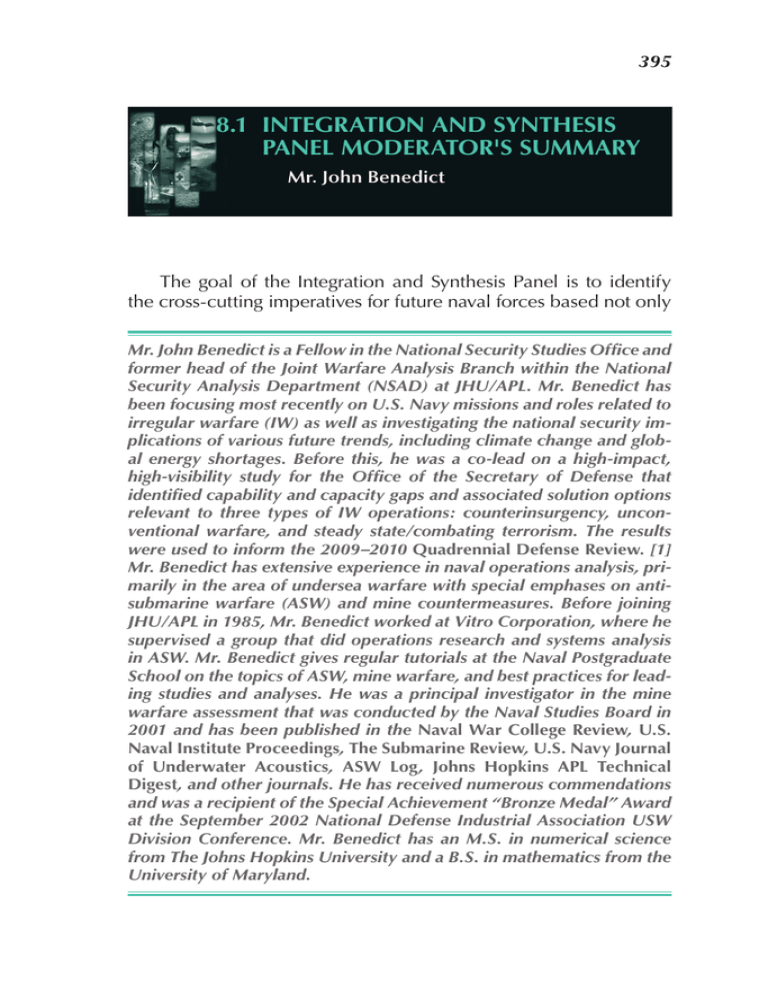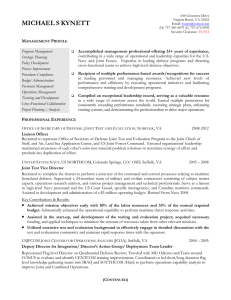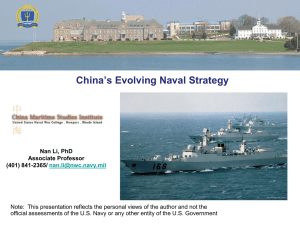8.1 INtEGRAtIoN AND SyNthESIS PANEL MoDERAtoR'S SuMMARy
advertisement

395 8.1 Integration and Synthesis Panel Moderator's Summary Mr. John Benedict The goal of the Integration and Synthesis Panel is to identify the cross-cutting imperatives for future naval forces based not only Mr. John Benedict is a Fellow in the National Security Studies Office and former head of the Joint Warfare Analysis Branch within the National Security Analysis Department (NSAD) at JHU/APL. Mr. Benedict has been focusing most recently on U.S. Navy missions and roles related to irregular warfare (IW) as well as investigating the national security implications of various future trends, including climate change and global energy shortages. Before this, he was a co-lead on a high-impact, high-visibility study for the Office of the Secretary of Defense that identified capability and capacity gaps and associated solution options relevant to three types of IW operations: counterinsurgency, unconventional warfare, and steady state/combating terrorism. The results were used to inform the 2009–2010 Quadrennial Defense Review. [1] Mr. Benedict has extensive experience in naval operations analysis, primarily in the area of undersea warfare with special emphases on antisubmarine warfare (ASW) and mine countermeasures. Before joining JHU/APL in 1985, Mr. Benedict worked at Vitro Corporation, where he supervised a group that did operations research and systems analysis in ASW. Mr. Benedict gives regular tutorials at the Naval Postgraduate School on the topics of ASW, mine warfare, and best practices for leading studies and analyses. He was a principal investigator in the mine warfare assessment that was conducted by the Naval Studies Board in 2001 and has been published in the Naval War College Review, U.S. Naval Institute Proceedings, The Submarine Review, U.S. Navy Journal of Underwater Acoustics, ASW Log, Johns Hopkins APL Technical Digest, and other journals. He has received numerous commendations and was a recipient of the Special Achievement “Bronze Medal” Award at the September 2002 National Defense Industrial Association USW Division Conference. Mr. Benedict has an M.S. in numerical science from The Johns Hopkins University and a B.S. in mathematics from the University of Maryland. 396 Climate and Energy Proceedings 2010 on what we’ve heard throughout this symposium but also, to some extent, on what we have not heard. We will not be synthesizing the science behind climate change and energy, but we will be synthesizing the operational and strategic implications of those changes for our naval forces. So please keep that in mind during the question and answer period. We heard about the tactical and operational effects of climate change, including the adverse effects of sea level rise and storm damage on the viability of military operating bases, and the potential for an increased role of naval support to civilian authorities during domestic disasters like Hurricane Katrina. We also heard about a potential increased Navy role as first responders for humanitarian assistance and disaster relief (HA/DR) operations and a likely increased role for sea basing during those operations. We also heard about the vulnerability of our national electric grid to storms, with potentially adverse effects on the U.S. Navy and other services in some situations. We heard that demand for some types of Navy missions could increase as a result of climate change effects—including search and rescue, medical evacuation, HA/DR, environmental stewardship, and maritime security. Shifting to the strategic level, we heard several times that climate change will exacerbate negative aspects of various societies. Things that are problems now will likely become more stressed when compounded by climate change. These changes could prove destabilizing in some regions and could even lead to failed states in some cases—think Somalia, think Darfur—based on regional food security issues, water availability and quality, spread of infectious diseases, and potential mass migrations and refugee crises. We did not hear as much about the likelihood of increased demand for international institutions, who might be asked to take on a new or enlarged role to mitigate some of these serious problems. We also heard little about how climate change could significantly impact virtually everything about the way the military and the Navy operate. Taking a regional perspective, we heard a lot about the Arctic. Open seas in the Arctic will provide opportunities for new Chapter 8 Integration and Synthesis 397 maritime shipping lanes and opportunities to harvest rich natural resources, with associated legal and sovereignty issues that are highlighted effectively in the presentations by Commander Kraska and Lieutenant Colonel Strader. We also heard about the potential for competition between the United States and Russia in the Arctic, and we even heard about possible U.S. and Canadian competition. Also discussed was the fundamental need for the Arctic nations, including the United States, to ensure safety, security, and stability in the region, with opportunities for new partnerships. We heard a long list of potential new Arctic missions and roles, including maritime security and awareness, presence, patrols, escort shipping, environmental protection, fisheries enforcement, freedom of navigation, and overflight. We had a similar list of potentially new Arctic capabilities that would be needed, starting with icebreakers, different ship designs, weather and ice forecasting, enhanced navigation and communication suites, and additional infrastructure, including potential deep water ports that currently do not exist. Shifting to Africa and the Middle East, we heard about climate-induced water and food shortages, with adverse effects and instabilities in various regions, including North Africa, the Sahel Region, the Horn of Africa, South Africa, Nigeria, Lagos and other mega-cities, mega-slums, and East Africa. Also mentioned was the potential for increased water-borne disease in sub-Saharan Africa, potential mass migrations in Nigeria and East Africa, humanitarian emergencies, and potential state failures. We heard less about the Middle East. Some potential effects were alluded to in some of the CNA material, but there are serious food, water, and resource shortages there. Two-thirds of the Arab world depends on water resources external to their borders, and 75% of the water in the Middle East is located in four countries. With regard to Asia, Australia, and New Zealand, we heard about potential large-scale flooding inundation and mass migration potentially in heavily populated mega-delta regions. Bangladesh in particular came up several times, with significant migration concerns for Pakistan, India, and China. We also heard about a 398 Climate and Energy Proceedings 2010 potential decrease in fresh water availability throughout Asia, particularly in large river basins, including large parts of India and China. The potential exists that the Gobi Desert could suddenly expand and that the melting of the glaciers in the Himalayas could eventually result in serious water shortages for hundreds of millions of people. We heard about low crop yields potentially in China and other places. As for Australia and New Zealand, Commander Cole from the Royal Australian Navy discussed the potential for a significant loss of biodiversity, water scarcity, and declines in crops and forestry. Shifting to Europe, the Americas, and island nations worldwide, we heard about the possibility of large-scale human migration issues, particularly from North Africa. We heard about desertification issues in southern Europe and about flash floods in other parts of Europe. However, we did not hear much about the potential fracturing of long-standing European alliances due to the pressures that can come from some climate-induced effects, particularly mass migrations, although these topics have been discussed at some length in other forums. We heard that the United States was very vulnerable to sea level rise, more frequent intense storms, potential water shortages in western states, and increased U.S. border stress. In Latin America, we heard about water-supply strains, disease outbreaks, and potential damage to the Amazonian rainforest. In the case of some of the more vulnerable island nations worldwide— Micronesia, for example—we heard about very serious issues with inundation, storm surge, and water scarcity. We also learned about climate change uncertainties—how soon and for how long will various parts of the Arctic be ice-free? Opinions vary from within a few years to as far out as 2060, with a median indication of sometime in the next 25–30 years. We also learned that the 2007 Intergovernmental Panel on Climate Change (IPCC) report probably seriously underestimated the sea level rise expected by the end of the century. Rather than the half-meter rise identified in the IPCC report, we’ve heard from several sources that it could be 1–2 meters or more. Chapter 8 Integration and Synthesis 399 The same report estimated global surface temperature rise from 1°C to 6.5°C by the end of the century, depending on various scenarios, which are largely about energy consumption and demand across the globe. If these forecasts are ultimately tightened, will today’s median estimates prove optimistic or pessimistic? We do not know. We did not hear as much about tying together observations and projections about climate change with social trends, such as demographics and poor governance. Once you’ve done that and tried to really delineate in more detail the combination of social trends and physical effects, how is that going to change U.S. and global security? I think there is more work to be done there that we did not accomplish at this conference. On the energy supply and demand side, at the tactical operational level, we heard a lot about over-reliance on oil on the battlefield; heavy just-in-time logistics potentially costly in dollars and lives, tying up combat assets and resulting in overall reduced combat effectiveness; and the need for more efficient approaches with less significant range and endurance constraints. We heard about the need for diversified energy sources to give us greater resilience, and we heard about our fragile electricity grid that is vulnerable to both natural and man-made threats. I was concerned that we would not hear a lot about the strategic implications of petroleum use, but General Wald and Vice Admiral McGinn provided considerable food for thought. In addition to the scenarios offered by Vice Admiral McGinn, I think there are many other very interesting low-level, middle-level, and highlevel scenarios where energy considerations are, or should be, pervasive. It is why you are there, it is what you are doing, it is what you are worried about protecting, it is what you are worried about getting. So I think that there is a lot that could be done here to help us understand why energy security is so important on a global level. At the strategic level, we learned about our dependence on imported oil, the potential adverse strategic consequences undermining various foreign policy initiatives, the resulting entanglements 400 Climate and Energy Proceedings 2010 with repressive autocratic regimes, and the tremendous transfer of wealth to a small group of supplier nations, which allows countries like Iran to both support terrorism and pursue nuclear weapons. In addition, large U.S. oil imports contribute to our growing debt, which is a national security issue itself. We heard about dependence on an increasingly tight supply of oil and other energy sources and the resulting volatile energy market. For the Navy, a $10 increase in the price of a barrel of oil will be felt as a $300 million increase in that service’s annual fuel bill. Under certain scenarios, we could be talking about price increases that are several multiples of $10. Market volatility was also mentioned, as was the possibility of intentional price manipulation of which the temporary denial of Russian natural gas to Europe was cited as an example. We also learned that energy nodes are very attractive targets for terrorists and insurgents and that we need to diversify in order to ensure resilience. We also have uncertainties with future energy supply and demand. There is obviously controversy about peak oil, although that specific term was not used much during the symposium. We did talk about oil crunches and reductions in supply. When will global oil production begin to diminish? We heard a range of answers, with some saying in a few years and others saying we are already there. The International Energy Agency’s chief economist, Dr. Fatih Birol, expects a plateau around 2020. Under the scenario that he has in mind, the world will need to find about 40 billion barrels per day of gross new capacity, equal to about four new Saudi Arabias, just to offset the decline that he thinks is going to happen on a business-as-usual case. We have opponents and proponents on both sides, notable people in organizations who think that there will be oil around for a long time and there will not be any oil crunch any time soon, and people who think we are already starting to see it. There is also some disagreement on the stability of fuel prices. Two views are: prices will remain volatile indefinitely, and we have no choice but to learn to live with it; or prices will largely stabilize, and what we had recently was an aberration. Chapter 8 Integration and Synthesis 401 In development, speed, and scalability of alternative energy sources, there is a large diversity of opinion. There are those who think that we can largely mitigate the problem with technology in the next 20–30 years, and there are others who think that we have significant limits on how rapidly we can implement alternative energy source solutions on the scales needed to replace fossil fuel. There are other relevant areas of uncertainty, too. For example, are energy security or rather energy insecurity and climate change mitigation measures largely in sync or somewhat at cross purposes? General Sullivan from the CNA Military Advisory Board stated—and I think he has really got it here—that energy, security, economics, and climate change are all interconnected. It is a system of systems. It is very complex, and we need to think of it that way. What about other drivers? How do they play? Globalization trends; wild cards such as pandemics; rising powers in a changing, diverse, multi-polar world power structure; shifts in the nature of power; shifts in the nature of war. Will states and institutions effectively address global regional problems? On energy, how long will rising powers rely on traditional Western market-based institutions? On climate, were the recent G-20 differences an aberration, or was that a forecast of a changing future with great difficulty in getting together on global approaches? On the economy, how long will rising powers be excluded from some of these institutions, or will rising powers not even want to join them and prefer regional or other approaches? On security, how effective will the G-20, the North Atlantic Treaty Organization, United Nations, and other international organizations be at addressing international security issues in the future? There is considerable uncertainty as to whether we can organize as a planet and implement some large-scale major mitigation and adaptation and prevention measures. In summary, I think that climate and energy imperatives will impose considerable demands on the Navy’s two new core capabilities identified in the 2007 Maritime Strategy: maritime security, and HA/DR. These capabilities will likely rise significantly in 402 Climate and Energy Proceedings 2010 importance, and not just on the margins. Maritime security activities will need to come in many flavors, including ones that have been done historically by other government agencies. In the future, the Navy will need to take on a set of tasks that includes environmental security, border migration security, fisheries and resources protection, and critical infrastructure protection. I also think that stability operations, and humanitarian assistance in general, will be increasingly important, with the U.S. Navy likely having an expanded role along with other services and agencies. Finally, there is a clear need for the United States and the U.S. military to partner with others to address these types of global or regional issues. They are far too challenging to take on alone. Reference 1. Department of Defense, Quadrennial Defense Review Report, Feb 2010, http://www.defense.gov/qdr/.


